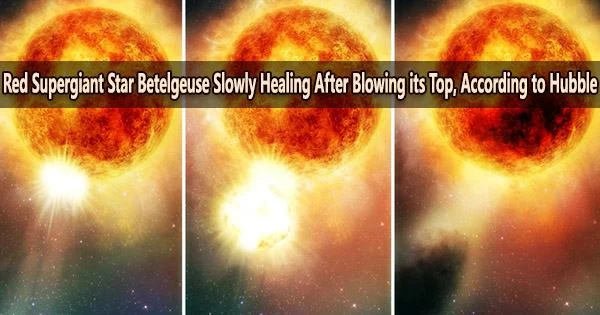On the top right shoulder of the winter constellation Orion the Hunter, there is a dazzling, ruby-red, sparkling speck of light that is the star Betelgeuse. Astronomers, however, recognize it as a seething monster with a 400-day-long heartbeat of regular pulsations when they look at it closely. This old star is a supergiant because of its astounding expansion to a diameter of almost 1 billion miles.
If placed at the center of our solar system it would reach out to the orbit of Jupiter. The star will eventually undergo a supernova explosion. When that eventually occurs, it will be momentarily observable from Earth in the midday sky. But there are a lot of fireworks going on now before the final detonation.
Astronomers using Hubble and other telescopes have deduced that the star blew off a huge piece of its visible surface in 2019.
This has never before been seen on a star. Mass ejections of the corona, our Sun’s outer atmosphere, occur often. Yet, compared to what was observed on Betelgeuse, those events are orders of magnitude weaker. The first clue came when the star mysteriously darkened in late 2019.
An immense cloud of obscuring dust formed from the ejected surface as it cooled. Astronomers have now pieced together a scenario for the upheaval. And the star is still slowly recovering; the photosphere is rebuilding itself.
The star’s regular cycle is being disturbed, and the inside is resonating like a bell that has been struck with a sledgehammer. Although the gigantic star is unlikely to explode anytime soon, scientists may still be astounded by its late-life spasms.
Astronomers have determined through studying data from NASA’s Hubble Space Telescope and a number of other observatories that the bright red supergiant star Betelgeuse essentially blew its top in 2019, losing a significant portion of its visible surface and creating a massive Surface Mass Ejection (SME). This is something never before seen in a normal star’s behavior.
Our Sun routinely blows off parts of its tenuous outer atmosphere, the corona, in an event known as a Coronal Mass Ejection (CME). But the Betelgeuse SME blasted off 400 billion times as much mass as a typical CME!
The monster star is still slowly recovering from this catastrophic upheaval. “Betelgeuse continues doing some very unusual things right now; the interior is sort of bouncing,” said Andrea Dupree of the Center for Astrophysics | Harvard & Smithsonian in Cambridge, Massachusetts.
These new discoveries provide information on how red stars lose mass toward the end of their lives when their nuclear fusion furnaces exhaust, leading to their eventual explosion as supernovae. The amount of mass loss significantly affects their fate.
However, Betelgeuse’s surprisingly petulant behavior is not evidence the star is about to blow up anytime soon. So the mass loss event is not necessarily the signal of an imminent explosion.
Dupree is currently piecing the celebrity’s obstinate conduct before, after, and during the eruption together into a coherent narrative of a hitherto unheard colossal convulsion in an old star.
This includes new spectroscopic and imaging data from the STELLA robotic observatory, the Fred L. Whipple Observatory’s Tillinghast Reflector Echelle Spectrograph (TRES), NASA’s Solar Terrestrial Relations Observatory spacecraft (STEREO-A), NASA’s Hubble Space Telescope, and the American Association of Variable Star Observers (AAVSO). Dupree emphasizes that the Hubble data was pivotal to helping sort out the mystery.
“We’ve never before seen a huge mass ejection of the surface of a star. We are left with something going on that we don’t completely understand. It’s a totally new phenomenon that we can observe directly and resolve surface details with Hubble. We’re watching stellar evolution in real-time.”
A convective plume that was more than a million miles across and was boiling up from the star’s interior may have been the origin of the colossal outburst in 2019. The cooling portion of the photosphere was blasted off by shocks and pulsations, leaving the star with a sizable cold surface area beneath the dust cloud it had created. Betelgeuse is now struggling to recover from this injury.
The fragmented photosphere, which was roughly several times as heavy as our Moon, flew off into space, cooled, and formed a dust cloud that obscured the star from Earth-based observers.
Even backyard watchers who watched the star’s brightness change were able to easily detect the fading, which started in late 2019 and continued for a few months. Betelgeuse, one of the brightest stars in the sky, may be easily located in Orion’s right shoulder.
The supergiant’s 400-day pulsation rate has disappeared, which is even more amazing. Astronomers have been measuring this rhythm for about 200 years, observing changes in Betelgeuse’s brightness variations and surface motions. Its disruption attests to the ferocity of the blowout.
Dupree hypothesizes that the convection cells inside the star, which are responsible for the regular pulsation, may be sloshing around like an unbalanced washing machine tub. The surface is still bouncing like a dish of gelatin dessert as the photosphere rebuilds itself, according to TRES and Hubble spectra, even if the outer layers appear to be returning to normal.
Astronomers have never seen such a significant portion of a star’s visible surface get blown into space, despite the fact that our Sun occasionally experiences coronal mass ejections that blast off small chunks of its outer atmosphere. Therefore, surface mass ejections and coronal mass ejections may be different events.
Betelgeuse has grown to such a size that if it were to take the place of the Sun as the primary star of our solar system, its surface would stretch beyond Jupiter’s orbit. Dupree used Hubble to resolve hot spots on the star’s surface in 1996.
This was the first direct image of a star other than the Sun. The ejected material may be visible to NASA’s Webb Space Telescope as it continues to move away from the star in infrared light.





